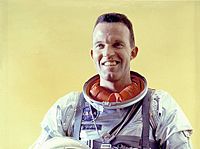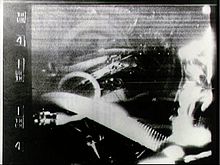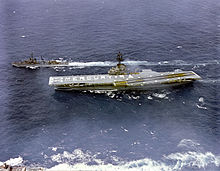- Mercury-Atlas 9
-
Mercury-Atlas 9 Mission insignia

Mission statistics Mission name Mercury-Atlas 9 Spacecraft name Faith 7 Spacecraft mass 1,360 kilograms (3,000 lb) Crew size 1 Call sign Faith 7 Launch vehicle Atlas LV-3B Launch pad LC-14 (CCAF) Launch date May 15, 1963, 13:04:13 UTC Landing May 16, 1963, 23:24:02 UTC
27°30′0″N 176°15′00″W / 27.5°N 176.25°WMission duration 1d/10:19:49 Number of orbits 22 Apogee 267 kilometers (144 nmi) Perigee 161 kilometres (87 nmi) Orbital period 88.5 min. Orbital inclination 32.5° Distance traveled 878,971 kilometres (546,167 mi) Maximum velocity 28,239 kilometres per hour (17,547 mph) Peak acceleration 7.6 g (75 m/s²) Crew photo 
Leroy Gordon "Gordo" Cooper, Jr. Related missions Previous mission Subsequent mission  MA-8
MA-8 Gemini 1
Gemini 1Mercury-Atlas 9 was the final manned space mission of the U.S. Mercury program, launched on May 15, 1963 from Launch Complex 14 at Cape Canaveral, Florida. The spacecraft, named Faith 7, completed 22 Earth orbits before splashing down in the Pacific Ocean, piloted by astronaut Gordon Cooper, then an Air Force major. The Atlas rocket was No. 130-D, and the Mercury spacecraft was No. 20.
Contents
Crew
Position Astronaut Pilot L. Gordon Cooper, Jr.
First spaceflightBackup crew
Position Astronaut Pilot Alan B. Shepard, Jr. Flight directors
- Chris Kraft—Red team
- John Hodge—Blue team
Mission parameters
- Mass: 3,000 pounds (1,400 kg)
- Perigee: 161 km
- Apogee: 267 km
- Inclination: 32.5°
- Period: 88.5 min
Mission highlights
The flight of Sigma 7 had been so nearly perfect that some at NASA thought America should quit while it was ahead and make MA-8 the last Mercury mission, and not risk the chance of future disaster. They thought NASA had pushed the first-generation Mercury hardware far enough, and taking more chances on another longer mission were not warranted. They thought it was time to move on to the Gemini program.
Manned Spacecraft Center officials, however, believed that the Mercury team should be given the chance to test man in space for a full day. In addition, all of the Soviet single-seat Vostok spacecraft launched after Vostok 1 lasted for more than a day, thus the Mercury 9 flight would bring the Mercury spacecraft up to the same level as that of the Soviets.
In September, 1962, NASA concluded negotiations with McDonnell to modify four Mercury spacecraft (#12, #15, #17 and #20) to a configuration that supported a one-day mission. Such changes to the spacecraft included the removal of the periscope, a redundant set of thrusters, and the addition of extra batteries and oxygen tanks.
In November, 1962, Gordon Cooper was chosen to pilot the MA-9 mission and Alan Shepard was picked as backup.
On April 22, 1963, Atlas booster 130-D and Mercury spacecraft #20 were stacked on the launch pad at Launch Complex 14.
Because MA-9 would orbit over nearly every part of the world from 32.5 degrees north to 32.5 degrees south, a total of 28 ships, 171 aircraft, and 18,000 servicemen were assigned to support the mission.
When Cooper boarded Faith 7 at 6:36 am on the morning of May 14, he found a little gift that had been left for him. Alan Shepard, knowing that Cooper would have a new version of the urine containment device that Shepard did not have on his Mercury-Redstone 3 flight (forcing him to relieve himself during a long countdown hold), had left behind a toilet plunger as a joke. Instructions on the handle said, "Remove Before Launch". The gift did not make the trip. Neither did Cooper that day. Various problems with radar in Bermuda and the diesel engine that rolls back the gantry caused the launch to be cancelled until May 15.
At 8:04:13 a.m. EST, May 15, 1963,[1] Faith 7 was launched from Launch Complex 14. At T+60 seconds, the Atlas started its pitch program. Shortly afterward, MA-9 passed through Max-Q. At T+2 minutes 14 seconds Cooper felt BECO (Booster Engine Cutoff) and staging. The two Atlas booster engines had been left behind. The Launch Escape Tower was then jettisoned. At T+3 minutes the cabin pressure sealed at 5.5 psi (38 kPa). Cooper reported, "Faith 7 is all go."
At about T+5 minutes was SECO (Sustainer Engine Cutoff) and Faith 7 entered orbit at 17,547 mile/h (7,844 m/s). After the spacecraft separated and turned around to orbit attitude, Cooper watched his Atlas booster lag behind and tumble for about eight minutes. Over Zanzibar on the first orbit, he learned that the orbital parameters were good enough for at least 20 orbits. As the spacecraft passed over Guaymas, Mexico still on the first orbit, capsule communicator Gus Grissom told Cooper the ground computers said he was "go for seven orbits".
At the start of the third orbit, Cooper checked his list of 11 experiments that were on his schedule. His first task was to eject a six-inch (152 mm) diameter sphere, equipped with xenon strobe lights, from the nose of the spacecraft. This experiment was designed to test his ability to spot and track a flashing beacon in orbit. At T+3 hours 25 minutes, Cooper flipped the switch and heard and felt the beacon detach from the spacecraft. He tried to see the flashing light in the approaching dusk and on the nightside pass, but failed to do so. On the fourth orbit, he did spot the beacon and saw it pulsing. Cooper reported to Scott Carpenter on Kauai, Hawaii, "I was with the little rascal all night." He also spotted the beacon on his fifth and sixth orbits.
Also on the sixth orbit, at about T+9 hours, Cooper set up cameras, adjusted the spacecraft attitude and set switches to deploy a tethered balloon from the nose of the spacecraft. It was a 30-inch (762 mm) PET film balloon painted fluorescent orange, inflated with nitrogen and attached to a 100 feet (30 m) nylon line from the antenna canister. A strain gauge in the antenna canister would measure differences in atmospheric drag between the 100 miles (160 km) perigee and the 160 miles (260 km) apogee. Cooper tried several times to eject the balloon, but it failed to eject.
Cooper passed Schirra's orbital record on the seventh orbit while he was engaged in radiation experiments. After T+10 hours, the Zanzibar tracking station informed Cooper the flight was a go for 17 orbits. Cooper was orbiting the Earth every 88 minutes 45 seconds at an inclination of 32.55 degrees to the equator.
His scheduled rest period was during orbits 9 through 13. He had a dinner of powdered roast beef mush and some water, took pictures of Asia and reported the spacecraft condition. Cooper was not sleepy and during orbit 9 took some of the best photos made during his flight. He took pictures of the Tibetan highlands and of the Himalayas.
Controversy arose during the flight when Cooper reported that he could see roads, rivers, small villages, and even individual houses if the lighting and background conditions were right. This was later confirmed by the two-man Gemini crews that later flew (of which Cooper was included). Cooper slept intermittently the next six hours, during orbits 10 through 13. He woke from time to time and took more pictures, taped status reports, and kept adjusting his spacesuit temperature control which kept getting too hot or too cold.
On his fourteenth orbit, Cooper took an assessment of the spacecraft condition. The oxygen supply was sufficient. The peroxide fuel for attitude control was 69 percent in the automatic tank and 95 percent in the manual one. On the fifteenth orbit, he spent most of the time calibrating equipment and synchronizing clocks.
When he entered night on the sixteenth orbit, Cooper pitched the spacecraft to slowly follow the plane of the ecliptic. Through the spacecraft window he viewed the zodiacal light and night airglow layer. He took pictures of these two "dim light" phenomena from Zanzibar, across the Earth's nightside, to Canton Island. The pictures were later found to have been overexposed, but they still contained valuable data.
At the start of the 17th orbit while crossing Cape Canaveral, Florida, Cooper broadcast slow scan black and white television pictures to the ground. The picture showed a ghostly image of the astronaut. In the murky picture, a helmet and hoses could be seen. It was the first time an American astronaut had sent back television images from space.
On the 17th and 18th orbits, Cooper took infrared weather photos and moonset Earth-limb pictures. He also resumed Geiger counter measurements of radiation. He sang during orbits 18 and 19, and marveled at the greenery of Earth. It was nearing thirty hours since liftoff.
Technical problems on the flight
On the nineteenth orbit, the first sign of trouble appeared when the spacecraft 0.05 g (0.5 m/s²) light came on. However, this turned out to be a faulty indicator, and the spacecraft was not reentering. On the 20th orbit, Cooper lost all attitude readings. The 21st orbit saw a short-circuit occur in the bus bar serving the 250 volt main inverter. This left the automatic stabilization and control system without electric power.
On the 21st orbit, John Glenn onboard the Coastal Sentry Quebec near Kyūshū, Japan, helped Cooper prepare a revised checklist for retrofire. Due to the system malfunctions, many of the steps would have to be done manually. Only Hawaii and Zanzibar were in radio range on this last orbit, but communications were good. Cooper noted that the carbon dioxide level was rising in the cabin and in his spacesuit. He told Carpenter as he passed over Zanzibar, "Things are beginning to stack up a little." Throughout the problems, Cooper remained cool, calm and collected.
At the end of the 21st orbit, Cooper again contacted Glenn on the Coastal Sentry Quebec. He reported the spacecraft was in retro attitude and holding manually. The checklist was complete. Glenn gave a ten-second countdown to retrofire. Cooper kept the spacecraft aligned at a 34 degree pitchdown angle and manually fired the retrorockets on "Mark!".
Fifteen minutes later the Faith 7 landed just four miles (6 km) from the prime recovery ship, the carrier USS Kearsarge. This was the most accurate landing to date, despite the lack of automatic controls. Faith 7 landed 70 nautical miles (130 km) southeast of Midway Island, in the Pacific Ocean.[2] This would be near 27°30′N 176°15′W / 27.5°N 176.25°W.
Splashdown was at T+34 hours 19 minutes 49 seconds after liftoff. The spacecraft tipped over in the water momentarily, then righted itself. Helicopters dropped rescue swimmers and relayed Cooper's request of an Air Force officer for permission to be hoisted aboard the Navy's carrier. Permission was granted. Forty minutes later the explosive hatch blew open on the deck of the Kearsarge. Cooper stepped out of the Faith 7 to a warm greeting.
After the MA-9 mission, there was another debate about whether to fly one more Mercury flight, Mercury-Atlas 10 (MA-10). It was proposed as a three day, 48 orbit mission to be flown by Alan Shepard in October 1963. In the end, NASA officials decided it was time to move on to Project Gemini and MA-10 never flew.
The Mercury program had fulfilled all of its goals.
Spacecraft location
The Faith 7 spacecraft is currently displayed at Space Center Houston, Houston, TX.
See also
References
- ^ Whitfield, Scott (2007). Project Mercury: Pocket Space Guide. Burlington: Apogee Books. pp. 44. ISBN 978-1-894959-53-7. http://www.apogeebooks.com.
- ^ NASA SP-45 "Mercury Project Summary Including Results of the Fourth Manned Orbital Flight"
- This New Ocean: A History of Project Mercury - NASA SP-4201
- NASA NSSDC Master Catalog
- Project Mercury - Results of the Fourth Manned Orbital Flight - NASA SP-45 - 1963
- Mercury-Atlas 9 Composite Air-to-Ground and Onboard Voice Tape Transcription
External links
- Field Guide to American Spacecraft Pictures of Faith 7 at the Johnson Space Center, TX museum.
Project Mercury Missions Unmanned: Little Joe 1 · Big Joe 1 · Little Joe 6 · Little Joe 1A · Little Joe 2 · Little Joe 1B · Beach Abort · Mercury-Atlas 1 · Little Joe 5 · Mercury-Redstone 1 · Mercury-Redstone 1A · Mercury-Redstone 2 · Mercury-Atlas 2 · Little Joe 5A · Mercury-Redstone BD · Mercury-Atlas 3 · Little Joe 5B · Mercury-Atlas 4 · Mercury-Scout 1 · Mercury-Atlas 5
Manned: Mercury-Redstone 3 · Mercury-Redstone 4 · Mercury-Atlas 6 · Mercury-Atlas 7 · Mercury-Atlas 8 · Mercury-Atlas 9Subprograms Rockets See also: Mercury 13 · Mercury Seven · Navy Mark IV ← 1962 · Orbital launches in 1963 · 1964 → Luna E-6 No.2 | OPS 0048 | OPS 0180 | Luna E-6 No.3 | Syncom 1 | OPS 0240 | OPS 0583 | OPS 0627 · P-11 No.1 | Kosmos 13 | OPS 0720 | Luna 4 | Explorer 17 | Transit 5A-2 | DS-P1 No.2 | Kosmos 14 | Kosmos 15 | OPS 1008 | OPS 1298 | Kosmos 16 | Telstar 2 | Midas 7 · Dash 1 · ERS-5 · ERS-6 · Westford 2 | Mercury-Atlas 9 (Balloon Subsatellite 2 · Flashing Light Unit) | OPS 0924 | Kosmos 17 | Kosmos 18 | DS-MT No.1 | OPS 0954 | Midas 8 · ERS-7 · ERS-8 | Vostok 5 | FTV-1292 · Solrad 6A · LOFTI 2B · Surcal 3 · Radose 112 | Transit 5A-3 | Vostok 6 | TIROS-7 | OPS 0999 · Hitchhiker 1 | GRS | OPS 1440 | Zenit-2 No.12 | OPS 1467 | OPS 1266 | Midas 9 · Dash 2 · ERS-9 · ERS-10 | Syncom 2 | OPS 1370 | Kosmos 19 | DS-A1 No.3 | OPS 1419 | OPS 1561 · LAMPO | OPS 1947 | OPS 1353 | OPS 1610 | Transit 5BN-1 · Transit 5E-1 | Vela 1A · Vela 1B · ERS-12 | Kosmos 20 | DS-A1 No.4 | OPS 2196 | OPS 2437 · Hitchhiker 2 | Polyot 1 | OPS 2268 | Kosmos 21 | Kosmos 22 | Explorer 18 | Atlas-Centaur 2 | OPS 2260 | Zenit-2 No.14 | Transit 5BN-2 · Transit 5E-2 | Kosmos 23 | OPS 2372 | Kosmos 24 | Explorer 19 | TIROS-8 | OPS 1388 · Hitchhiker 3Payloads are separated by bullets ( · ), launches by pipes ( | ). Manned flights are indicated in bold text. Uncatalogued launch failures are listed in italics. Payloads deployed from other spacecraft are denoted in brackets. Categories:- 1963 in spaceflight
- Human spaceflights
- Mercury program
Wikimedia Foundation. 2010.





